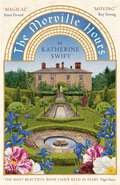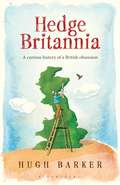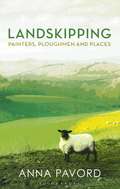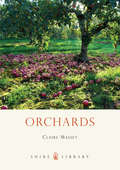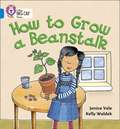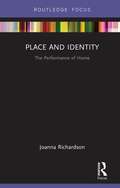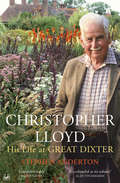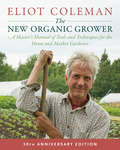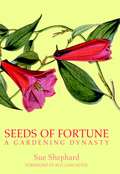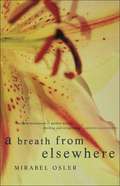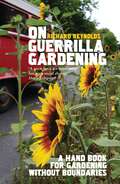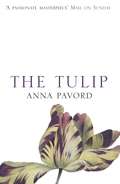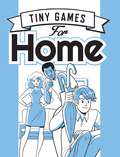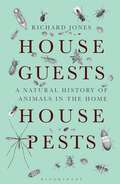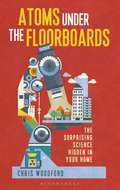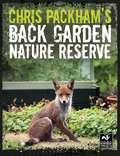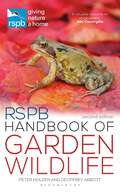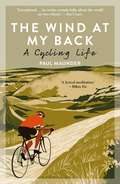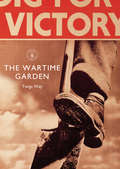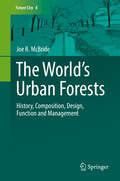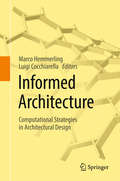- Table View
- List View
The Curious Gardener
by Anna PavordIn The Curious Gardener, Anna Pavord brings together in 12 chapters - one from each month of the year - 72 pieces on all aspects of gardening. From what to do in each month and how to get the best from flowers, plants, herbs, fruit and vegetables, through reflections on the weather, soil, the English landscape and favourite old gardening clothes, to office greenery, spring in New York, waterfalls, Derek Jarman and garden design, Anna Pavord always has something interesting to say and says it with great style and candour.The perfect book to guide you through the gardening year and, on days when the weather keeps the most courageous gardener indoors, the perfect book to curl up with beside the fire.
The Morville Hours: The Story of a Garden
by Katherine SwiftIn 1988 Katherine Swift arrived at the Dower House at Morville to create a garden of her own. This beautifully written, utterly absorbing book is the history of the many people who have lived in the same Shropshire house, tending the same soil, passing down stories over the generations. Spanning thousands of years, The Morville Hours takes the form of a medieval Book of Hours. It is a meditative journey through the seasons, but also a journey of self-exploration. It is a book about finding one's place in the world and putting down roots.
Hedge Britannia: A Curious History of a British Obsession
by Hugh BarkerThis is the story of how Britishhedgerows contribute to our national identity and our wildlife. Overthe centuries we have proved ourselves to be a nation of hedge growers,marking boundaries or trimming them into fantastical creations. Fromformal garden features to emphatically rustic barriers, Hugh exploresour hedges in all their diversity.Hedge Britannia offers a wittyinsight into the history of hedges and the way they relate to ourculture as well as our landscape. Hugh travels the breadth of Britainmeeting fellow enthusiasts who range from horticultural experts to theBrixton man who lovingly cultivated a whale-shaped hedge and ran intotrouble with the local council. As well as two full-colour platesections, there are case studies about hedges of particular note, likethe towering Meikleour beech hedge, the castellated hedge and spectacular topiary at LevensHall and the bamboozling hedge maze at Chatsworth (where Hugh gotpredictably and happily lost).Both pithy and informative, this is The Cloudspotter's Guide meets Flora Britannica.
Landskipping: Painters, Ploughmen and Places
by Anna PavordLandskipping is a ravishing celebration of landscape, its iridescent beauty and its potential to comfort, awe and mesmerise. In spirit as Romantic as rational, Anna Pavord explores the different ways in which we have, throughout the ages, responded to the land. In the eighteenth century, artists first started to paint English scenery, and the Lakes, as well as Snowdon, began to attract a new kind of visitor, the landscape tourist. Early travel guides sought to capture the beauty and inspiration of waterfall, lake and fell. Sublime! Picturesque! they said, as they laid down rules for correctly appreciating a view. While painters painted and writers wrote, an entirely different band of men, the agricultural improvers, also travelled the land, and published a series of remarkable commentaries on the state of agricultural England. They looked at the land in terms of its usefulness as well as its beauty, and, using their reports, Anna Pavord explores the many different ways that land was managed and farmed, showing that what is universal is a place's capacity to frame and define our experience.Moving from the rolling hills of Dorset to the peaks of the Scottish Highlands, this is an exquisite and compelling book, written with zest, passion and deep understanding.
Orchards (Shire Library #632)
by Claire MassetSome of Britain's surviving orchards are almost six hundred years old, and whether laden with summer fruit or stripped bare by the winter are places of great beauty. Throughout history, they have played an important role in life both rural and urban, providing not just food and drink but also a haven for wildlife and a setting for age-old customs and social gatherings. But when did orchards first appear? What is wassailing and who did it? Why has England lost almost two-thirds of its orchards since 1950 – and what is being done about it today? This beautifully illustrated book reveals the engaging story and rich diversity of Britain's apple, pear and cherry orchards.
Collins Big Cat Phonics — How to Grow a Beanstalk: Band 04/Blue (PDF) (Collins Big Cat Phonics Ser. (PDF))
by Janice Vale Kelly Waldek Collins Big Cat StaffDo you know how to turn a small, fat thing into a long, thin thing? It’s easy – just take a bean and grow a beanstalk! This simple instruction text shows you exactly how to do it. • Blue / Band 4 - A simple instruction text • Text type - Non-fiction • The focus phonemes in this book are ur (curl), al and ow (how). • The flow chart on the final spread gives children the chance to recap and discuss the different stages of the process. • Janice Vale also wrote Yellow 3 Rock Out. • This book has been levelled for Reading Recovery.
Place and Identity: The Performance of Home (PDF) (Routledge Focus On Housing And Philosophy Ser.)
by Joanna RichardsonThe UK is experiencing a housing crisis unlike any other. Homelessness is on the increase and more people are at the mercy of landlords due to unaffordable housing. Place and Identity: Home as Performance highlights that the meaning of home is not just found within the bricks and mortar; it is constructed from the network of place, space and identity and the negotiation of conflict between those – it is not a fixed space but a link with land, ancestry and culture. This book fuses philosophy and the study of home based on many years of extensive research. Richardson looks at how the notion of home, or perhaps the lack of it, can affect identity and in turn the British housing market. This book argues that the concept of ‘home’ and physical housing are intrinsically linked and that until government and wider society understand the importance of home in relation to housing, the crisis is only likely to get worse. This book will be essential reading for postgraduate students whose interest is in housing and social policy, as well as appealing to those working in the areas of implementing and changing policy within government and professional spaces.
Place and Identity: The Performance of Home (Routledge Focus On Housing And Philosophy Ser.)
by Joanna RichardsonThe UK is experiencing a housing crisis unlike any other. Homelessness is on the increase and more people are at the mercy of landlords due to unaffordable housing. Place and Identity: Home as Performance highlights that the meaning of home is not just found within the bricks and mortar; it is constructed from the network of place, space and identity and the negotiation of conflict between those – it is not a fixed space but a link with land, ancestry and culture. This book fuses philosophy and the study of home based on many years of extensive research. Richardson looks at how the notion of home, or perhaps the lack of it, can affect identity and in turn the British housing market. This book argues that the concept of ‘home’ and physical housing are intrinsically linked and that until government and wider society understand the importance of home in relation to housing, the crisis is only likely to get worse. This book will be essential reading for postgraduate students whose interest is in housing and social policy, as well as appealing to those working in the areas of implementing and changing policy within government and professional spaces.
Christopher Lloyd: His Life at Great Dixter (Pimlico Ser.)
by Stephen AndertonChristopher Lloyd (Christo) was one of the greatest English gardeners of the twentieth century, perhaps the finest plantsman of them all. His creation is the garden at Great Dixter in East Sussex, and it is a tribute to his vision and achievement that, after his death in 2006, the Heritage Lottery Fund made a grant of £4 million to help preserve it for the nation. This enjoyable and revealing book - the first biography of Christo - is also the story of Dixter from 1910 to 2006, a unique unbroken history of one English house and one English garden spanning a century. It was Christo's father, Nathaniel, who bought the medieval manor at Dixter and called in the fashionable Edwardian architect, Lutyens, to rebuild the house and lay out the garden. And it was his mother, Daisy, who made the first wild garden in the meadows there. Christo was born at Dixter in 1921. Apart from boarding school, war service and a period at horticultural college, he spent his whole life there, constantly re-planting and enriching the garden, while turning out landmark books and exhaustive journalism. Opinionated, argumentative and gloriously eccentric, he changed the face of English gardening through his passions for meadow gardening, dazzling colours and thorough husbandry. As the baby of a family of six - five boys and a girl - Christo was stifled by his adoring mother. Music-loving and sports-hating, he knew the Latin names of plants before he was eight. This fascinating book reveals what made Christo tick by examining his relationships with his generous but scheming mother, his like-minded friends (such as gardeners Anna Pavord and Beth Chatto) and his colleagues (including his head gardener, Fergus Garrett, a plantsman in Christo's own mould).
The New Organic Grower, 3rd Edition: A Master's Manual of Tools and Techniques for the Home and Market Gardener, 30th Anniversary Edition
by Eliot ColemanThe Book that Started the Organic Farming Revolution Since its original publication in 1989, The New Organic Grower has been one of the most important farming books available, with pioneer Eliot Coleman leading the charge in the organic movement in the United States. Now fully illustrated and updated, this 30th Anniversary Edition is a must-have for any agricultural library. Eliot Coleman’s books and innovative methods have helped innumerable organic farmers build successful farms in deep accordance with nature. The wisdom in this seminal book holds true even as the modern agricultural canon has grown—in large part due to Coleman’s influence as a wise elder with decades of experience. New information has been included in this edition to showcase the new tools and techniques that Eliot has been developing over the last thirty-five years. Inspired by the European intensive growers, The New Organic Grower, 30th Anniversary Edition, offers a very approachable and productive form of farming that has proven to work well for the earth and its stewards for centuries. Gardeners working on 2.5 acres or less will find this book especially useful, as it offers proof that small-scale market growers and serious home gardeners can live good lives close to the land and make a profit at the same time. The New Organic Grower is ideal for young farmers just getting started, or gardeners seeking to expand into a more productive enterprise. New material in this edition includes: Beautiful color photographs throughout, taken by master gardener and author Barbara Damrosch (Eliot’s wife and co-farmer) Updated information throughout on how Eliot’s practices have changed through his experiments over the years A new section from Damrosch about incorporating flowers on the small farm More information on new tools Eliot has invented that don’t appear in any of his other books
A Gentle Plea for Chaos: Reflections From An English Garden
by Mirabel OslerIn this book the author describes the way her garden evolved and how, without meaning to do so, she let it take over her life. She suggests moving away from planning, regimentation and gardening with the mentality of a stamp-collector. Frequently funny and always stimulating, she writes of the alchemy of gardens, of the 19th-century plant-collectors and plant illustrators and of the gardening philosophers, all fertilizing great thoughts along with their hollyhocks. She won the 1988 Sinclair Consumer Press Garden Writer of the Year Award.
Seeds of Fortune: A Gardening Dynasty
by Sue Shephard Roy LancasterFor over a century, and across five generations, the Veitch family pioneered the introduction of hundreds of new plants into gardens, conservatories and houses and were amongst the foremost European cultivators and hybridisers of their day. The story begins in 1768 when a Scotsman called John Veitch came to England to find his fortune, starting out as a gardener for the aristocracy. Realising that horticultural mania had begun to spread throughout the social classes, John's son, James, opened a nursery in Exeter and began to send some of the first commercial plant collectors into the Americas, Australia, India, Japan, China and the South Seas. By the beginning of the twentieth century, the Veitch's had become key figures within the gardening establishment, involved with the Royal Horticultural Society from its beginnings and the great Chelsea Flower Show. Combining an historian's eye for detail with a flair for storytelling, Shephard charts the fortunes of one family and through them tells the fascinating story of the modern English garden.
A Breath from Elsewhere: Musings on Gardens
by Mirabel OslerMirabel Osler attempts in this work to take the reader beyond her own garden, offering encouragement to all gardeners, especially novices, to ignore books and try whatever appeals to them.
On Guerrilla Gardening: A Handbook for Gardening without Boundaries
by Richard ReynoldsOn Guerrilla Gardening is an activist's call to arms to all citizens - green-fingered, green-thinking or curious - to join the revolution of guerrilla gardening: transforming public space into oases of colour and life. The enemy: neglect, apathy and the disintegration of community spirit. The arsenal: daring, a packet of seeds and a passionate commitment to social change. When Richard Reynolds first embarked on guerrilla gardening, growing flowers by moonlight outside his tower block, he had no idea it was part of a growing global movement committed to cultivating the potential in the land regardless of all obstacles. Charting the battles fought across thirty different countries and the revolutionary history of this subculture, On Guerrilla Gardening is an inspirational take on gardening in the 21st century.
The Tulip: Twentieth Anniversary Edition
by Anna PavordTHE TULIP is not a gardening book. It is the story of a flower that has made men mad. Greed, desire, anguish and devotion have all played their part in the development of the tulip into the world-wide phenomenon it is today. No other flower has ever carried so much cultural baggage; it charts political upheavals, illuminates social behaviour, mirrors economic booms and busts, plots the ebb and flow of religious persecution. Pavord tells how the tulip arrived from Turkey and took the whole of Western Europe by storm. Sumptuously illustrated from a wide range of sources, this beautifully produced and irresistible volume will become a bible, a unique source book, a universal gift book and a joy to all who possess it.
Tiny Games for Home (Osprey Games Ser.)
by Hide Seek Paulina GanucheauDesigned to give the maximum amount of fun for the minimum amount of rule-reading, Tiny Games for Home will let you find the perfect game for whatever situation you're in. All you need is this book, and the stuff that's around you. (Friends optional) There are games to play with spoons and sofas and TVs and turnips and books and bottles. Games about words, games about celebrities, games about the things and the people and the places in your life. Games for TV commercial breaks, games for toast, and games for lying in bed. Whether you're feeling creative or competitive, silly or energetic, we've got you covered."It's like carrying around a collection of Victorian parlour games – except the Tiny Games take advantage of modern social settings and contexts. They're amusing, raucous and inventive†? - The Guardian
House Guests, House Pests: A Natural History Of Animals In The Home (Bloomsbury Nature Writing Ser.)
by Richard JonesToday we live in snug, well-furnished houses surrounded by the trappings of a civilised life. But we are not alone – we suffer a constant stream of unwanted visitors. Our houses, our food, our belongings, our very existence are under constant attack from a host of invaders eager to take advantage of our shelter, our food stores and our tasty soft furnishings.From bats in the belfry to beetles in the cellar, moths in the wardrobe and mosquitoes in the bedroom, humans cannot escape the attentions of the animal kingdom. Nature may be red in tooth and claw, but when it's our blood the bedbugs are after, when it's our cereal bowl that's littered with mouse droppings, and when it's our favourite chair that collapses due to woodworm in the legs, it really brings it home the fact that we and our homes are part of nature too.This book represents a 21st century version of the classic Mediaeval bestiary. It poses questions such as where these animals came from, can we live with them, can we get rid of them, and should we? Written in Richard Jones's engaging style and with a funky-retro design, House Guests, House Pests will be a book to treasure.
Atoms Under the Floorboards: The Surprising Science Hidden in Your Home
by Chris WoodfordUsing the modern home as a springboard, Atoms under the Floorboards introduces the reader to the fascinating and surprising scientific explanations behind a variety of common (and often entertainingly mundane) household phenomena, from gurgling drains and squeaky floorboards to rubbery custard and shiny shoes. Packed with facts and fun, each chapter focuses on a feature in each of the areas and slowly unpicks the science behind it.* Is it better to build skyscrapers like wobbly jellies or stacks of biscuits? *Can you burn your house down with an electric drill? *How many atoms would you have to split to power a lightbulb? *How can a raincoat be waterproof and breathable at the same time? Atoms under the Floorboards answers all these questions, and hundreds more. You'll never look at your home the same way again ...
Chris Packham's Back Garden Nature Reserve (The Wildlife Trusts)
by Chris PackhamMany of Britain's plants and animals have come to rely upon gardens as an essential lifeline as their natural habitats come under increasing pressure from human activity and global warming. This comprehensive book explains the best ways to attract wildlife to gardens and encourage it to stay there. Written in a light-hearted yet passionate and authoritative style, the guide challenges popular notions of 'weeds' and 'pests' and invites gardeners to think again about the choices they make.Chris Packham's informative and lively text is complemented by attractive photographs and illustrations that will encourage an interest in the natural world on your doorstep, whether your 'garden' is a rural idyll or an urban window box. Chris argues that we have become so spellbound by 'nature's celebrities' – tigers, pandas and their ilk – that we are in danger of overlooking the most exciting species of all: those that we can touch, smell and observe in our own backyard.
RSPB Handbook of Garden Wildlife: Second Edition (RSPB)
by Peter Holden Geoffrey AbbottThis friendly handbook is full of practical advice on attracting wildlife to your garden, and encouraging creatures to stick around, as well as expert tips on green gardening, seasonal planting and garden predators.Colour photographs illustrate hundreds of mammals, birds, insects, invertebrates, reptiles and amphibians, flowers, trees, shrubs and fungi, while the comprehensive text explains everything you need to cultivate a haven for nature.The new edition includes additional species as well as fully updated text describing the diverse wildlife that can be found in British gardens. Finally, a DIY chapter is packed with projects for your garden, from building bat boxes to digging your own pond.
RSPB Gardening for Wildlife: New edition (RSPB)
by Adrian ThomasThere is something uplifting about having butterflies in your flowerbeds, frogs in your water feature and birds in your bushes, and knowing they're there because of you. Rich in detail and accessible in style, Gardening for Wildlife is the crucial companion to novices and expert gardeners alike. Adrian Thomas dispels myths and offers new insights and ideas, helping everyone understand what to do so gardens, large or small, can become ideal homes for wildlife.Building on the success of the award-winning first edition, this expanded and updated edition reflects the latest research and developments in nature-friendly gardening.The book serves as an expert guide to the practical aspects of this rewarding pastime and educates readers about the ecological principles involved, while exploding commonly held misconceptions that often deter people from pursuing a kinder approach to gardening.Adrian Thomas provides a detailed guide to the many and varied species that can contribute to a natural and healthy garden. Practical sections help you create entire habitats, such as woodland and meadow gardens, in your garden. And the massively expanded catalogue of the top 500 best garden flowers, shrubs and trees for wildlife, now includes colour photos of every species.If you love wildlife and want to encourage more to visit your garden, this inspirational book will help you sow the seeds and reap the rewards.
The Wind At My Back: A Cycling Life
by Mr Paul MaunderA lone cyclist, disappearing into a wild landscape – brave, free, engaged with the world. It's the kind of image that sells bikes, magazines, clothing; a romantic image that all cyclists aspire to. For cycling is an activity deeply and intimately involved with landscape. The bicycle allows us to explore, to engage with wild places, and return in time for dinner. It also allows us to investigate our surroundings closer to home. It is an activity which, for most of us, happens at a speed that allows a great deal of voyeurism. We peer into houses and shops, gardens and farmyards, fields and hedgerows. What we see may be familiar or alien, but for the creative mind it is always stimulating. Yet – unlike with walking or swimming – the connection between cycling and creativity has only been explored in fragments.On a bicycle, as one is exposed to sights – new or otherwise, through chance or purposeful searching – the repetitive physical actions of cycling work on the mind in a different way to those of walking. The shape of a long ride can become the shape of a novel; the atmosphere imbued by the weather, the hills, the physical exertion, can all influence a writer's tone. Our memories have a dialogue with the landscape; we remember rides through the landscape, and the landscape shapes our thinking. And for Paul Maunder – a writer all his adult life – cycling and creativity have always been interlinked. In The Wind on Your Back, Maunder takes a journey from the most dense centres of population to the wild places; starting from cycling in a major city, then moving through suburbia, the edgelands at the periphery of the city, then into the managed and pastoral farmland, and beyond to the sublime mountains.He explores the experience and history of cycling in these different types of place, and seeks to understand how cycling has played a role in his own creative life as well as that of other cyclist-artists, musicians, photographers, writers and painters. Played out against the backdrop of the British countryside, and drawing of elements of psychogeography and human geography, Maunder seeks to understand the way the outside world interacts with the creative mind, and the way our surroundings help to shape who we are.
The Wartime Garden: Victory (Shire Library)
by Sarah Rutherford Twigs WayThis War is a Food War…' In 1941 Lord Woolton, Minister for Food, was determined that the Garden Front would save England: 'Dig for Victory' was the slogan, digging for dinner the reality. With food imports dwindling the number of allotments grew, millions opted to 'Spend an Hour with a Hoe' instead of an hour in a queue, and the upper classes turned lawns, tennis courts and stately gardens over to agriculture. The national diet was transformed, with swedes grown in the place of oranges and hapless children sucking on carrot lollies; evacuees grew their own meals and bomb sites sprouted allotments. Vegetables ruled the airwaves with Mr Middleton's 'In Your Garden' whilst Home Guard potatoes became the favourites of the Kitchen Front. This is a fully illustrated look at the time when gardening saved Britain.
The World’s Urban Forests: History, Composition, Design, Function and Management (Future City #8)
by Joe R. McBrideThe purpose of this book is to examine urban forests in cities around the world. It will ask questions about the history, composition, structure, and management of trees in urban areas. Data for this book was collected in 33 cities across broad geographical areas known as biomes. Constraints and opportunities imposed on urban forest composition, design, and management by the ecological characteristics of these biomes will be examined. The book will also address the cultural and historical factors that influenced the characteristics of urban forests around the world.
Informed Architecture: Computational Strategies in Architectural Design
by Marco Hemmerling Luigi CocchiarellaThis book connects the different topics and professions involved in information technology approaches to architectural design, ranging from computer-aided design, building information modeling and programming to simulation, digital representation, augmented and virtual reality, digital fabrication and physical computation. The contributions include experts’ academic and practical experiences and findings in research and advanced applications, covering the fields of architecture, engineering, design and mathematics. What are the conditions, constraints and opportunities of this digital revolution for architecture? How do processes change and influence the result? What does it mean for the collaboration and roles of the partners involved. And last but not least: how does academia reflect and shape this development and what does the future hold? Following the sequence of architectural production - from design to fabrication and construction up to the operation of buildings - the book discusses the impact of computational methods and technologies and its consequences for the education of future architects and designers. It offers detailed insights into the processes involved and considers them in the context of our technical, historical, social and cultural environment. Intended mainly for academic researchers, the book is also of interest to master’s level students.

